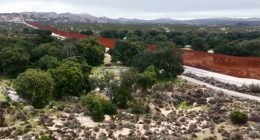HAVING just released the deepest image of the universe to date, Nasa will today release more mind-blowing snaps taken by the most powerful telescope ever built.
The full set of the James Webb Space Telescope’s first colour images will be published during a televised broadcast that kicks off at 10:30 a.m. EDT (3:30 p.m. BST) on Tuesday, July 12.
It follows yesterday’s reveal of the first colour image from JWST, which entered Earth’s orbit in January.
The first in a series of images to be released this week, it is the deepest and sharpest infrared image of the distant universe to date.
The reveal marked a major moment for the space observatory and signalled the start of scientific operations for the $10billion mission.
JWST will peer deeper into the universe than any telescope before it to unravel the secrets of time and space.


The release of the latest batch of images is to be broadcast from NASA’s Goddard Space Flight Center in Greenbelt, Maryland.
As well as featuring on Nasa’s dedicated TV channel, the show will also be live-streamed worldwide on Nasa’s website.
Released one by one, these first images will demonstrate JWST at its full power, ready to begin its mission.
Each image will be published on social media as well as on the agency’s website at: nasa.gov/webbfirstimages.
Most read in Tech
JWST launched on Christmas Day in 2021 and was built with help from the European and Canadian space agencies.
It has spent the last seven months parked 1,000,000 miles from Earth, unfolding its sunshield, calibrating the tech onboard, and adjusting to the challenging temperatures of space.
Its aim is to uncover the hidden depths of our universe, peering at early stars and galaxies created after the Big Bang.
It achieves this using delicate infrared sensors that pick up the faint light given off by celestial objects.
The telescope has been angled to take images of the Carina and Southern Ring Nebulae, a gaseous exoplanet, and a galaxy cluster.
Hank Green, an author, and trusted science vlogger told his 1.2million Twitter followers that “the promise of Webb has always been to see farther away (and thus farther back in time) than we have ever seen.”
Indeed, the images from Webb are glimpses into the past – the light from deep space has traveled to the lens of the James Webb telescope over light-years of expanse.
The same principle applies to the Sun: light from the Sun takes a bit more than eight minutes to reach Earth.
The first images captured by the James Webb were presented on Nasa TV and on Nasa’s socials during a speech by President Joe Biden.
“This first image from NASA’s James Webb Space Telescope is the deepest and sharpest infrared image of the distant universe to date,” Nasa said of the image.
“Known as Webb’s First Deep Field, this image of galaxy cluster SMACS 0723 is overflowing with detail.
“Thousands of galaxies – including the faintest objects ever observed in the infrared – have appeared in Webb’s view for the first time.”
“You’re seeing galaxies that are shining around other galaxies whose light has been bent. And you’re seeing just a small little portion of the universe.”
Nasa went on to say that the slice of the vast universe covers a “patch of sky approximately the size of a grain of sand held at arm’s length by someone on the ground.”
The agency said capturing the image was all in a day’s work for the Webb telescope as capturing it took less than a day.


A few engineers got a sneak peek at the images that are going public this week.
“What I have seen moved me, as a scientist, as an engineer, and as a human being,” Nasa deputy administrator Pam Melroy said.
This post first appeared on Thesun.co.uk












